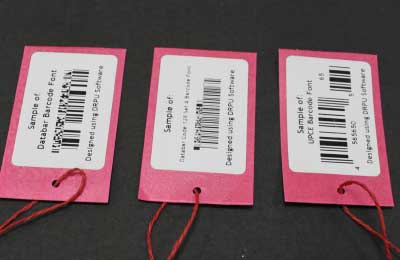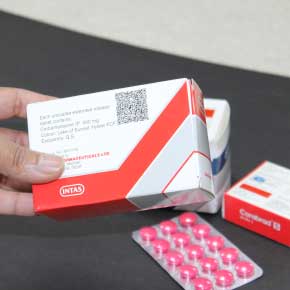Types of Barcodes Commonly Used in Hospitals
There are several types of barcodes used in the medical industry, each with their own specific use cases and requirements. Some of the most commonly used medical barcodes include:
The use of barcodes in hospitals has become essential for delivering high-quality patient care. By using barcodes to track and manage patient information, medical equipment, and supplies, hospitals can improve patient safety, reduce errors, and streamline various processes, ultimately leading to better patient outcomes.
Barcodes are used extensively in the healthcare industry, particularly in hospitals, to improve patient safety, track inventory and supplies, and streamline various processes. Here are some of the most commonly used barcodes in hospitals:
-
Code 128:
Code 128 is a barcode format that is commonly used in the medical industry for labeling and tracking patient records, medical specimens, and laboratory samples. Code 128 barcodes can encode alphanumeric characters, making them useful for labeling items with complex data, such as patient names, medical record numbers, and test results. Code 128 barcodes are used in hospitals to label and track medical devices and equipment, such as IV pumps or ventilators.
-
Data Matrix:
Data Matrix is a two-dimensional barcode format that is commonly used in the medical industry for labeling and tracking small medical devices and components, such as syringes, catheters, and surgical implants. Data Matrix barcodes are small and can store a large amount of information, making them ideal for labeling small items with complex data. Data Matrix barcodes are becoming increasingly popular in hospitals for tracking and managing inventory and supplies.
-
QR Code:
QR (Quick Response) Code is a two-dimensional barcode format that is commonly used in the medical industry for patient identification, medication administration, and inventory management. QR codes store more information than traditional one-dimensional barcodes, making them useful for labeling items with a lot of data, such as medication dosage. QR codes are used in hospitals to provide quick access to patient information, such as medical history or current medications.
-
2D Barcodes:
2D barcodes, such as QR codes, can store much more data than linear barcodes. They consist of a matrix of small squares that represent data in two dimensions. 2D barcodes are often used in healthcare to store detailed patient information, such as medical histories and treatment plans. They can be read using specialized barcode scanners or even smartphones. 2D barcode encode large amounts of data. 2D barcode that is commonly used in logistics and manufacturing settings.
-
Linear Barcodes:
Linear barcodes are the most common type of barcode used in healthcare. They consist of a series of vertical bars and spaces of varying widths that represent numbers and other data. Linear barcodes can be read quickly and easily using handheld barcode scanners, and are often used to track medications, medical devices, and patient information.
-
RFID Tags:
(RFID) Radio frequency identification tags ae uses to radio waves to transmit information between a tag and a reader. Radio frequency identification tags can be used to track, manage medical equipment and supplies, as well as patients. RFID tags are often used in hospitals to monitor patient movements and ensure receiving correct treatments medications.
 Compared to
other barcode systems, healthcare barcodes often include more detailed information
about patient care and treatment, such as medication dosages and expiration dates.
Additionally,
healthcare barcodes may be designed to be more durable and resistant to wear and tear, since
they are often used in a clinical setting where spills, stains, and other damage can occur.
Compared to
other barcode systems, healthcare barcodes often include more detailed information
about patient care and treatment, such as medication dosages and expiration dates.
Additionally,
healthcare barcodes may be designed to be more durable and resistant to wear and tear, since
they are often used in a clinical setting where spills, stains, and other damage can occur.
Overall, the use of barcodes in the healthcare industry has helped to improve patient safety, reduce medication errors, and streamline operations. By using barcodes to track medications, supplies, and patient information, healthcare providers can deliver more effective care and ensure that patients receive the right treatment at the right time.
Future of Barcode Technology in Medical Care and Improvement in Patient Safety and Care
The future of barcode technology in medical care is expected to see significant growth and development, with several advancements that will improve patient safety and care in several ways:
-
Medication safety:
Barcode technology can be used to improve medication safety by ensuring that the right medication is given to the right patient at the right time, reducing the risk of medication errors.
-
Medical supply chain management:
Barcode technology can be used to improve supply chain management of medical products, reducing the risk of counterfeit or expired products being used on patients.
-
 Patient tracking:
Patient tracking:
Barcode technology can be used to track patients through the hospital, ensuring that they receive the right treatment and reducing the risk of miscommunication between healthcare providers.
-
Electronic health records:
Barcode technology can be used to improve the accuracy and completeness of electronic health records, reducing the risk of medical errors and improving patient outcomes.
-
Remote patient monitoring:
Barcode technology can be used to enable remote patient monitoring, allowing patients to receive medical care in the comfort of their own homes and reducing the need for hospitalization.
Overall, the future of barcode technology in medical care looks promising, with continued advancements that will improve medication safety, supply chain management, patient tracking, electronic health records, and remote patient monitoring. These innovations will help to improve patient safety and care, making medical care more efficient, effective, and patient-friendly.
Difference of Medical Barcodes from Barcodes used in Other Industries
Medical barcodes differ from barcodes used in other industries in several ways.
- ➥ Firstly, medical barcodes often have unique requirements for durability, accuracy, and readability. Medical devices and products must be able to withstand harsh environments, such as exposure to chemicals and sterilization processes, without compromising the integrity of the barcode. Additionally, medical barcodes must be readable by specialized barcode scanners and software that are designed to handle medical data and comply with regulatory standards.
- ➥ Secondly, medical barcodes often have unique data requirements, such as the need to encode lot numbers, expiration dates, and other information required for compliance with regulatory standards. For example, medical devices and products may require unique identification numbers that are registered with regulatory agencies, such as the FDA, to ensure that they are safe and effective.
- ➥ Finally, medical barcodes often require additional security and privacy measures to protect patient data and comply with HIPAA regulations. This may include using specialized software and hardware to ensure that medical data is encrypted, and restricting access to sensitive data to authorized personnel only.
Overall, medical barcodes play an important role in the medical industry by enabling accurate and efficient tracking of medical products, devices, and patient data. By using specialized barcode formats and complying with regulatory requirements, the medical industry can ensure that patients receive safe and effective care, while also improving efficiency and reducing costs.
Accuracy and Quality of the Barcode Information in Hospitals
Hospital staff can ensure the accuracy and quality of the information encoded in barcodes by following these steps:
-
Validate Data Accuracy
Before applying a barcode label to a patient or an asset, ensure that the information to be encoded is correct and up-to-date. Use the hospital's information management system to validate data accuracy.
-
Use a Reliable Barcode Scanner
Choose a reliable barcode scanner that can accurately read and decode the information encoded in the barcode label. Test the scanner regularly to ensure that it is working correctly.
-
Verify Information
After scanning a barcode label, always verify the information displayed on the scanner's screen to ensure that it matches the patient or asset you are tracking.
-
Proper Application of Barcode Labels
Ensure that barcode labels are properly applied and are not damaged, soiled, or defaced in any way. The barcode should be in a location that is easily accessible and scannable.
-
Regular Maintenance
Regularly maintain the barcode scanner, labels, and other hardware components to ensure they are functioning correctly.
-
Training
Provide regular training to hospital staff on how to use the barcode system, including how to scan and validate information, proper application of barcode labels, and regular maintenance of the system.
By following these steps, hospital staff can ensure the accuracy and quality of the information encoded in barcodes, which is critical to providing safe and effective patient care.
